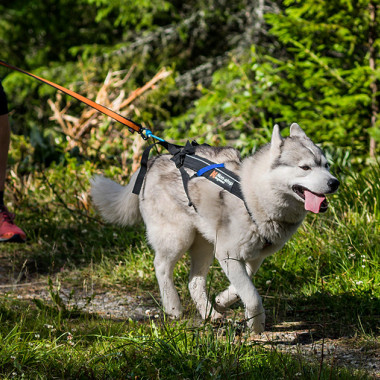A dog is a pack animal. In modern times, it can be seen as a great team player. They help us in hunting, work, or as emotional support. Although their behavior and needs may sometimes seem simple to us, their sensory abilities are almost supernatural compared to ours.
Dogs have five senses: sight, smell, hearing, taste, and touch. While their sense of touch and taste may be somewhat less sensitive than ours, their sense of smell, hearing, and sight are, in some aspects, many times more sensitive.
Sight
The field of vision plays a significant role. The field of vision is the range we are able to see. A dog’s eyes are positioned more on the sides of the head compared to ours, which gives them a panoramic view of the world, meaning they have better peripheral vision than we do. The range and width of the image depend on the type of head. For example, brachycephalic breeds, like the Pug, have eyes positioned more forward, similar to humans, which results in a panoramic view not much different from ours. On the other hand, dolichocephalic breeds, like the Borzoi (Russian Sighthound), have eyes positioned more on the sides, giving them a much wider field of vision and, therefore, broader peripheral vision. Their visual abilities are particularly useful in hunting or other work.
Smell
A dog’s nose is the most dominant feature of its face. It is a tool that controls the brain and together they determine the dog’s perception of the world. For dogs, smell is the primary and probably the most important sense. For us humans, sight is the most important sense, as it communicates the most with our thinking and thus determines how we perceive the world around us. In the brain, there is a center for distinguishing odors, which is significantly less developed in humans compared to dogs. For comparison, it weighs four times less than in an average-sized dog, even though the brain of such a dog is only about one-tenth the size of a human brain. Essentially, this means that a dog’s brain is primarily focused on the need to analyze smells, and its ability to analyze odors is 40 times higher than in humans. Dogs can recognize scents that we cannot perceive because our brains are unable to detect them. Their nose is therefore up to 10,000 times better than ours.
We like to use the professional smelling abilities of dogs in national security services or in rescuing the lost, trapped in ruins, or even in searching for avalanche victims. Even modern technology sometimes cannot replace the extraordinarily sensitive ability of dogs to distinguish scents.
The sensitivity of a dog’s nose is also of interest to medicine. In 1989, what is likely the first report of a dog detecting cancer in its early stages was published. It appeared in the Lancet journal by doctors Hywel Williams and Andres Pembroke, who mentioned a case where a dog alerted its owner to a pigmented spot on her thigh. This spot, upon examination, turned out to be a malignant melanoma. The doctors stated in the article that the dog saved the woman’s life by prompting her to seek medical help. How could the dog sense it? Malignant tumors produce a unique scent (they create different proteins), which is undetectable to humans but easily distinguishable to dogs.
This case caught the attention of police dog handler Duane Pickel, who began training dogs to detect serious illnesses before it’s too late. It has been proven that dogs can be trained to detect cancer and other diseases in humans. Cancer cells release different metabolic byproducts than healthy cells in the human body. Dogs can even sniff out cancer cells simply by smelling someone’s breath (lung cancer), urine (prostate cancer), skin (skin cancer), saliva (tuberculosis), or detect the onset of various types of seizures. A dog’s sense of smell works perfectly with its brain and can decipher even the smallest differences in odors. At the same time, it can quickly learn what is or isn’t important.
Hearing
The ability to detect sound depends on its characteristics, such as intensity, volume, and, importantly, frequency. Individual tones mean variations in pressure occurring predominantly in a regular rhythm. This phenomenon is called wave or sound frequency waves. The frequency of sound itself determines the length of the wave range, creating differences in the perception of the pitch of the tone.
Compared to us, dogs have much more sensitive hearing for high and low tones. The ability to perceive these tones depends on the size of the dog, primarily the size of its head. In larger breeds, with large heads and ears, the internal structure of the ear canal is larger, and the ear canals themselves are further apart, allowing them to better perceive low tones. On the other hand, in small breeds, the ear canals are more sensitive to high-pitched sounds, as narrow canals better capture high tones.
Thanks to their ability to recognize sounds at frequencies that humans cannot perceive, dogs can locate living persons in ruins, under avalanches, as they can hear ultrasounds coming from beneath various deep layers. Some dogs, through their hearing, can predict impending earthquakes, avalanches, or other natural disasters before they occur. Stories of dogs warning of natural disasters through their behavior have led to speculation that dogs can sense electrostatic changes or slight ground vibrations, but it essentially involves highly sensitive detection of low tones caused by mass movements beneath the earth’s surface.
In addition to these physiologically proven facts, people also recount personal experiences, claiming that dogs have a “sixth sense.” This includes the ability to predict misfortune, sense the arrival of a family member, or perceive and point out supernatural phenomena. The evidence for these experiences is still subjective and very difficult to scientifically confirm. Whether or not you believe that your dog has a sixth sense is entirely up to you.










